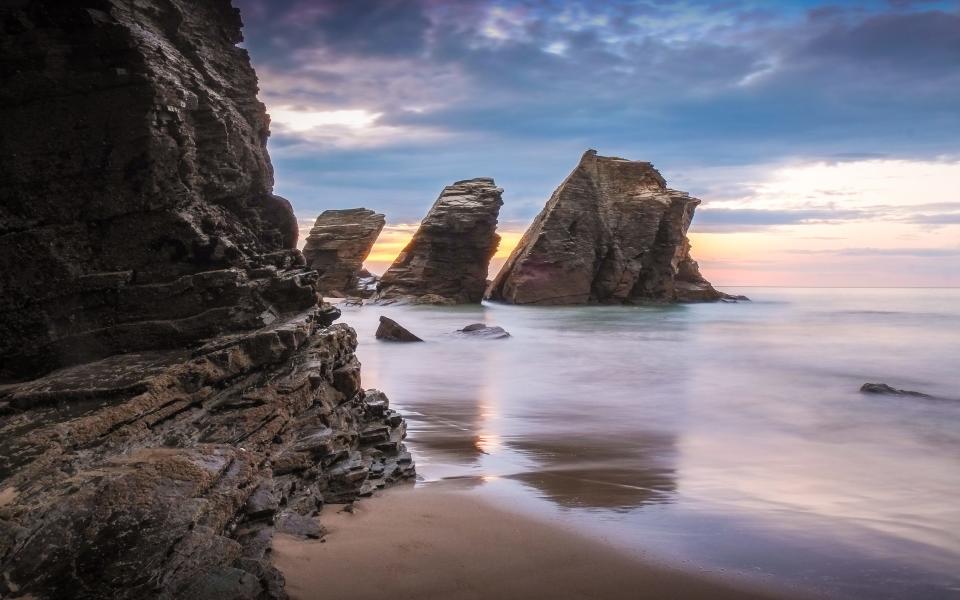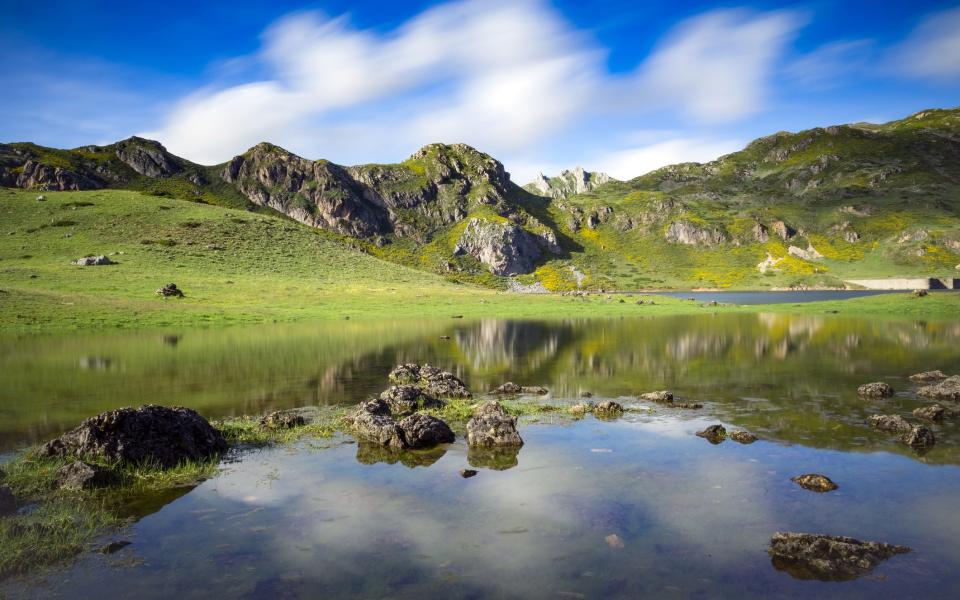It’s almost as if Asturias was designed by a clever algorithm to keep everyone happy. You don’t have to choose between beaches or mountains, or between a city trip or an active holiday; this compact region in northern Spain has it all. So it is no wonder that so many Spaniards have a second home there. Personally, I would just go for the cheese.
Tourists can also receive the memo soon. The region just became easier to reach by train, with a brand new high-speed line connecting Madrid to Oviedo in just over three hours.
The Principality of Asturias describes itself as a ‘natural paradise’ and for once this is not just a banal marketing slogan. Between Cantabria and Galicia it extends about 320 kilometers from east to west and 80 kilometers from north to south. This is a country where the mountains start just behind the coast, with emerald green meadows and apple orchards in between.
Traveling through the region you will come across pre-Romanesque churches, but also surprising contemporary architecture; you can walk through spectacular scenery in the hills in the morning and flop on an idyllic beach in the afternoon.
Although it rains more here than in the south of the country, this creates those lush landscapes. In summer it’s less oppressively hot than southern and eastern Spain, meaning you can actually spend more of the day on the beach – and Asturias has real beaches, with crescents of white sand on the ridges of cliffs. If you have only experienced the Spain of package holidays in large resorts, you will feel like you are in another country.
The cities
Oviedo, Gijón and Avilés form a triangle in the center of Asturias and have very different characters, but each has its own charm. Elegant Oviedo, the regional capital, is unusually unspoilt for a city, with café terraces in pedestrianized squares in its medieval core. At night, however, it gets lively, with people pouring into the streets from noisy cider bars. Stay in historic splendor at the five-star Eurostars La Reconquista hotel (eurostarshotels.co.uk; doubles from around £100).


On the coast with beautiful city beaches, Gijón is the largest city in Asturias with a large port and a dynamic gastronomic and cultural scene. Stroll through the old town on the Cimadevilla headland that divides the bay, and don’t miss the Atlantic Botanical Gardens (botanico.gijon.es) and the vast Laboral cultural complex (laboralciudaddelacultura.com). The Santa Rosa hotel, with contemporary decor in a traditional building, is an unpretentious place to stay in a convenient location (bluehoteles.es/santa-rosa; doubles from around £70).
After decades of being associated with the iron and steel industry, Avilés now attracts many more tourists, both from Spain and abroad. Many flock to the Centro Oscar Niemeyer cultural center (centroniemeyer.es), a futuristic white blob designed by the prestigious Brazilian architect in his 90s and opened in 2011 when he was 103.
The medieval heart of the city is remarkably well preserved, with opulent mansions, colorful fishermen’s houses, pretty squares and porticoes with tapas bars. The five-star Palacio de Avilés hotel is housed in a palatial 17th-century building on the city’s main square (melia.com; doubles from around £70).
The landmarks
Prehistoric settlements have been discovered in caves in Asturias, with beautiful Palaeolithic art at Tito Bustillo (centrotitobustillo.com) near Ribadesella, Pindal in the cliffs at Ribadedeva, Buxu in Cangas de Onís and La Lluera in San Juan de Priorio.
Covadonga, in the Picos de Europa, is recognized as the birthplace of Christian Spain, as it was here in the early eighth century that King Pelayo triumphed over the Moors, beginning the reconquest that would last another seven centuries. The dramatic mountain site is now a sanctuary, marked by a pink granite basilica (realsitiodecovadonga.com).


In the ninth century, King Alfonso II established his court in Oviedo as he ventured to the site that would become Santiago de Compostela to see the tomb of Saint James. He was therefore the first pilgrim and the catalyst for the now world-famous pilgrimage to the Galician capital. Oviedo Cathedral (catedraldeoviedo.com) has a special significance as the starting point of the camino primitivo, as this original pilgrimage route is called.
Just outside the city are the special pre-Romanesque churches of Santa María del Naranco, San Miguel de Lillo and San Julián de los Prados, and there are more in the region (prerromanicoasturiano.es).
The coast
You can enjoy spending a week or two traveling along the coast, discovering pristine beaches (there are more than 200 to choose from) and staying in fishing villages and quiet resorts.
Cudillero, with rows of pastel-coloured houses on the hill above the harbour, is a great place for a seafood lunch and is close to Playa del Silencio, one of the region’s most dramatic beaches, which looks like the crater of a sea. volcano.


The stretch from Villaviciosa to Ribadesella is known as the Jurassic Coast because so many tracks of dinosaurs and other reptiles have been discovered there. Head to La Griega beach to see giant footprints and fossils along the way, then stroll around nearby Lastres, where the Spanish version of the TV series Doc Martin was filmed.
The seaside town of Llanes in the east is a popular base, with colorful mansions built by wealthy emigrants returning from America in the early 20th century. Among the many beaches in and around the resort is Torimbia, a truly beautiful stretch of fine sand that is among the best in Spain.


The interior
Head inland from the coast and drive through rural landscapes of rolling hills, apple orchards and green meadows, punctuated by hórreos, the raised granaries that you also see in Galicia – the difference being that in Asturias they are made of wood instead of granite. Although this is a beautiful region to explore by car, you’ll need to put on your walking boots or get on a bike to get the full impact of the experience. Asturias attracts many professional mountain climbers and cyclists, but there are routes for all levels and ages.
The three massifs of the Picos de Europa, Spain’s first national park, separate Asturias from the rest of Spain. With dramatic jagged peaks, lakes and flower-filled valleys, the landscape is nothing short of breathtaking and the mountain range is unsurprisingly one of the top destinations for nature lovers in Spain. Cangas de Onís is a good base for all kinds of activities, with a particularly attractive Parador in a former monastery (telegraph.co.uk/paradordecangasdeonis; doubles from around £80).
Asturias is also one of the few places in Europe where you can see brown bears in the wild. The best place to spot them is the Somiedo Nature Park, where in addition to wolves you can also encounter griffon vultures, golden eagles and a wide variety of butterflies.
You can find more information at the Fundación Oso Pardo information center (fundacionosopardo.org) in Pola de Somiedo, and book a bear watching excursion with Somiedo Experience (somiedoexperiment.com). Stay at the family-run Palacio Flórez-Estrada (telegraph.co.uk/palacioflorezestrada; doubles from around £70).


Food and drink
With a wide variety of excellent products from the sea, mountains, rivers and lush countryside, Asturias is one of Spain’s best gastronomic regions. Stop somewhere along the coast for a seafood lunch, including mussels, velvet crabs, hake or monkfish. Look out for sea urchins – erizos –, one of the many specialties. If you don’t feel like tackling the spiky creatures, try the rich pate on a slice of bread.
After a morning walk through the hills, you’ll be ready for your fabada: the region’s signature stew, made with a local variety of butter beans, pork, black pudding and chorizo. If you’re really hungry, order a cachopo, which are two cutlets – often the size of a plate – filled with ham and cheese, covered in breadcrumbs and fried.
I’m certainly not alone in my passion for the cheeses of Asturias – there are around 40 to choose from. The most famous is the tantalizing blue Cabrales, which is made in small dairies and aged in caves. You can visit a number of them in and around Arenas de Cabrales – a must for turophiles.
Although some wine is made in the Cangas de Narcea region, cider is the regional drink, poured from a height to create a bit of fizz. Although it’s served in thick cups, you only get a few inches of it at a time, which you quickly knock back before it goes flat.
Where to stay
Asturias was a pioneer of rural tourism in Spain and you can stay in small, characterful places all over the region. Rustical Travel (rusticaltravel.com) and Caminos by Casas Cantabricas (caminos.co.uk) have a good selection of self-catering accommodation. Casonas Asturianas (casonasasturianas.com) brings together hotels in traditional buildings, from farmhouses to grand Casas de Indianos.
How do you get there?
By plane: Vueling (vueling.com) flies from Gatwick to Asturias Airport, which is 16 km from Avilés and 45 km from both Oviedo and Gijón. Ryanair (ryanair.com) flies there from Stansted. You can also fly to Santander with Ryanair or to Bilbao.
By ferry: Brittany Ferries (brittanyferries.com) sails from Plymouth, Portsmouth and Cork to Santander and from Portsmouth to Bilbao. The drive along the coast to the Asturian border takes 45 minutes from Santander and one hour and 45 minutes from Bilbao.
Per track: You can book tickets for the new Madrid-Oviedo high-speed line at thetrainline.com.